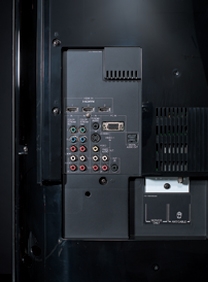Toshiba REGZA 46-Inch LED-Backlit LCD HDTV

| Key Features |
| $2,300 (list) tacp.toshiba.com |
| • 46-inch, 1080p-resolution screen • LED backlight with local dimming • 120-Hz display with ClearScan 240 blur-reduction mode • Dolby Volume auto sound level adjustment • IR output for pass-through device control • USB port with DivX video, JPEG photo, and MP3 media player • SD card slot with JPEG photo media player • A/V Inputs: (4) HDMI, (2) component, (2) composite-, and S-video; (4) RCA stereo analog audio and minijack stereo analog audio; RF Ant/Cable; RGB PC • Outputs: coaxial digital audio and stereo analog audio • Dimensions + Weight 45 1?2 x 31 x 13 1?2 in; 72 3?4 lb (with stand) |
LED backlights and local-dimming processing have done much to close the performance gap between LCD and plasma, the other major flat-panel TV technology. But while plasma sets sell at attractive prices, these new LCDs with their tricked-out backlights go for a premium. To give you just one example, a 46-inch version of the Sony XBR8-series LCD that I tested at this time last year cost a cool $4,000. Toshiba's new 46SV670U, on the other hand, lists for $2,300 and can be found in stores for $1,700. All in all, that's a reasonable amount to pay for a TV capable of delivering deep blacks. But what else besides black does Toshiba's first LED-backlit/local-dimming LCD bring to the party?
This set has many of the same features found on the company's 47ZV650U model, which I tested for our October 2009 issue, including Dolby Volume and ClearScan 240. The latter is a selectable mode designed to reduce blur on fast-motion images. (In reality, the 46SV670U has a 120-Hz refresh rate, but when ClearScan 240 is turned on, its backlight is scanned to create a 240-Hz-like effect - something I'll talk more about in the Performance section of this review.)
Another thing this TV shares with the 47ZV650U is that set's "Deep Lagoon" bezel. According to Toshiba's literature, this design is "inspired by nature and reminiscent of sand disappearing below the surface of calm shores." That sounds good to me. Looks pretty good, too: The TV's edge-fade effect definitely helps it blend in visually with its environment. The 46SV670U also comes with a swiveling stand - always a nice extra.
Inputs on the Toshiba's back panel include three HDMI and two component-video jacks, and an RGB PC port. A side-panel A/V convenience jack-pack offers up a fourth HDMI input, along with a USB port and an SD card slot. You can plug flash media into either of these to view slideshows of JPEG pictures. The set's media player can also play DivX movie and MP3 music files via USB but not via SD card.
Toshiba's remote is a handful and lacks amenities like a backlit keypad, but I had no problems using it in a dark room since the control buttons I find myself pushing most often were easy to locate. The REGZALink function lets you control an HDMI-connected Blu-ray Disc player using the TV's remote. And with Toshiba's infrared blaster cable accessory (not included) connected to the set's IR output, you can program the remote to control additional components stashed away in an A/V cabinet. Pressing the remote's Picture Size button lets you toggle through the TV's display options. These include a Native mode that shows 1080i, 1080p, and 720p signals, as well as 480i and 480p ones arriving via HDMI, with no overscan. Other options include three TheaterWide modes that zoom and stretch 4:3 and 16:9 images to varying degrees.
SETUP
| The 46SV670U offers a handful of preset picture modes, including an AutoView option, where the TV makes adjustments for you based on room lighting conditions and the content of programs being displayed. Most modes can be fully adjusted for each input, and the TV stores your settings. Another feature, TheaterLock, lets you secure those settings so that other family members don't grab the remote and commit the unpardonable crime of altering your meticulously tuned picture adjustments. Beyond its basic picture controls, the Toshiba's Advanced Picture Settings menu provides a bunch of additional modes to tweak performance. The one you'll want to hit first is DynaLight, which enables local dimming - an essential function for getting good blacks from this TV. |  |
|---|
And there's also Film Stabilization, which must be set to Standard to enable 2:3 pulldown processing for viewing film-based programs. A second option, Smooth, triggers frame-interpolation processing to reduce the motion-judder effects characteristic of programs shot on film.) I liked that Toshiba separated out this set's dejudder processing from its blurreduction mode. On many other LCDs, those two features simply get bundled together into a single adjustment.
 | Other picture tweaks that I found useful during setup included Static Gamma, a feature that provides an unusually wide range of options to modify the appearance of shadows and highlights in images; ColorMaster, which lets you individually adjust hue, saturation, and brightness levels for primary and secondary colors; and Expert Mode, which has controls to turn red, green, and blue channels on and off when adjusting color via test patterns on setup discs. Toshiba's color-temperature setting offers 11 increments for adjusting grayscale (of these, the 1 setting came closest to hitting the 6,500-K standard mark), along with RGB offset and gain controls to dial it in more precisely (a procedure that requires special test equipment). |
|---|
Toshiba's color-temperature setting offers 11 increments for adjusting grayscale (of these, the 1 setting came closest to hitting the 6,500-K standard mark), along with RGB offset and gain controls to dial it in more precisely (a procedure that requires special test equipment). There's also an adjustment called Resolution +, which is meant to punch up apparent detail in soft-looking standard-def pictures. Like other SD enhancement modes, this feature can add unnatural ringing to object edges, so it should be applied with caution.
- Log in or register to post comments




















































